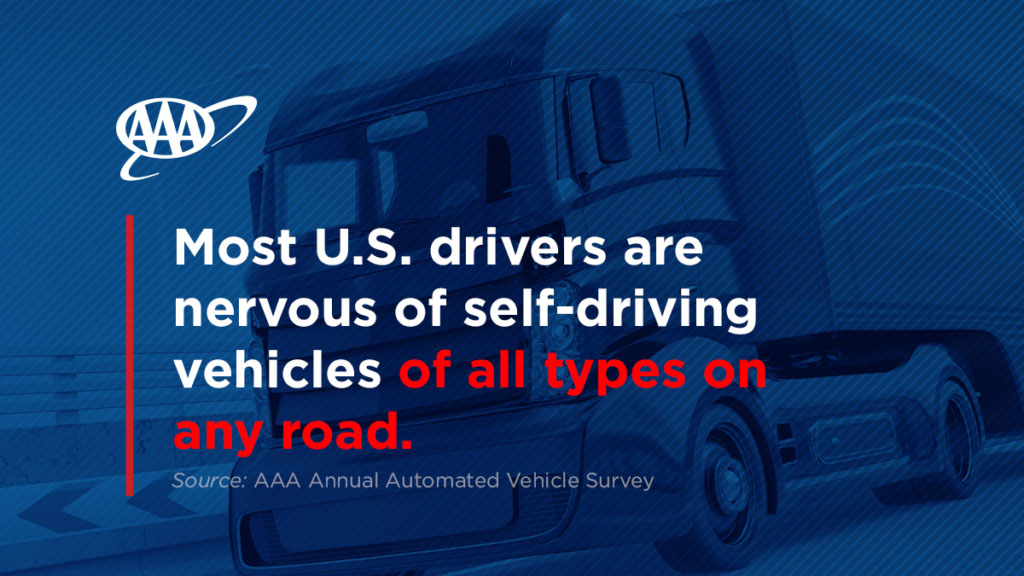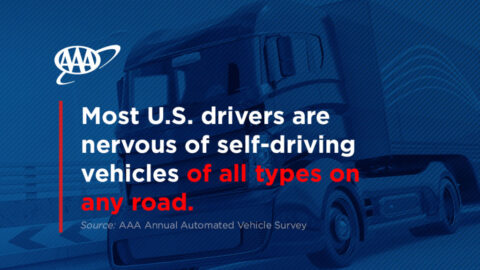 Washington, D.C. – Over the next two years as on-road pilot programs and testing increase, self-driving vehicles will continue to move from novelty to closer to reality, meaning more drivers are likely to encounter them.
Washington, D.C. – Over the next two years as on-road pilot programs and testing increase, self-driving vehicles will continue to move from novelty to closer to reality, meaning more drivers are likely to encounter them.
Regulators must establish guidelines that ensure self-driving test vehicles are identifiable and consistent in their actions while on the road with human drivers, cyclists, and pedestrians. Doing so will enhance people’s trust in self-driving vehicles while paving the way for drivers to safely interact with automated vehicle technology.
Big or small, fast or slow … people are worried about driving alongside self-driving vehicles
AAA recently teamed up with the Technology and Public Purpose Project at Harvard Kennedy School’s Belfer Center for Science and International Affairs to survey United States drivers to gain greater insight into how they felt about sharing the road with self-driving vehicles.
The survey found that most U.S. drivers have concerns, with the vehicle type and driving scenario making little to no difference in easing that apprehension.
| Sharing the road with … | Safer | No Difference | Less Safe | Unsure |
| Self-driving semi-trucks | 11% | 12% | 53% | 24% |
| Small, self-driving delivery vehicles | 12% | 19% | 43% | 26% |
| Self-driving vehicles on a highway or freeway | 13% | 15% | 47% | 24% |
| Self-driving vehicles on local or neighborhood roads | 13% | 17% | 44% | 26% |
Despite these concerns, though, the survey also found that implementing certain measures would ease driver anxiety.
| Which would make you feel safe … | |
| Clear markings that the vehicle is self-driving | 62% |
| Designated lanes for self-driving vehicles only | 60% |
| Restrictions on times of day and/or days of the week when self-driving vehicles can use the roads | 31% |
Self-driving vehicle pilots are in full swing in many states
Currently, 38 states and the District of Columbia have active programs that allow self-driving test vehicles to operate on public roads. While some are highly publicized, others are not as heavily promoted. Researchers at AAA and Harvard also wanted to learn more about people’s awareness and acceptance of these types of programs.
The survey found that only 35% of U.S. drivers know that some states allow self-driving test vehicles on public roads. Support of these programs was split across the board 34% of drivers in favor, 36% opposed, and 31% unsure about it.
Among those opposed, top concerns included:
- The safety of sharing the road with self-driving vehicles (77%)
- Who would be responsible for crashes with self-driving vehicles (62%)
- Lack of clarity about who would oversee the test vehicles (56%)
- The need for educating the public about how to behave around these vehicles (51%)
- Drivers not knowing if a nearby vehicle is self-driving (50%)
As state programs continue to grow, it is critical for policymakers and other state government officials to take actions that will build confidence and foster public acceptance of self-driving vehicles.
This research identified four key areas of focus:
- Self-driving vehicles demonstrate safe and predictable behavior – as defined by regulators – when in use on public roads and highways.
- Self-driving vehicles operate consistently and as designed.
- The public clearly understands who would be responsible in the event of a crash with a self-driving vehicle.
- The public can easily and quickly identify when sharing the road with a self-driving vehicle.
AAA believes that addressing these issues provides a real way of enhancing public perception and acceptance of self-driving vehicles. Previously AAA has found that sentiment towards automated vehicle technology has remained stagnant over the years.
A collective effort by both industry and consumers will go a long way in moving the needle away from apprehension and closer toward acceptance.




